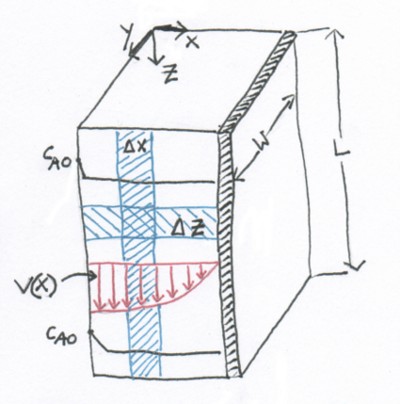Section 17.5: Diffusion into a Falling Liquid Film:
Forced Convection Mass
Transfer
Bird, Stewart, and Lightfoot. Transport
Phenomena. John Wiley and Sons. 1960.
A Project by Amanda Watford & Judy Hsii
_______________________________________________________________________________
This section of the text deals with an illustration of forced-convection mass transfer. The conditions under which the viscous flow and diffusion occur allow the velocity field to be viturally unaffected by diffusion. The absorption of gas A can then be considered by a laminar falling film of liquid B. Some of the assumptions and restrictions are as follows:
· Material A is only slightly soluble in material B.
This makes the viscosities not change appreciably.
· Diffusion takes place very slowly in the film.
Material A willl thus not infiltrate a great distance into material B.
The penetration distance will be small relative to the thickness of the film.

Using Maple V, we hope to setup the equations that are indicative of the process described above.
We start by
establishing a mass balance on component A.
The concentration of A, cA, will change with both x and z.
_______________________________________________________________________________
> restart;
An essential command at the start of each new Maple worksheet.
We start by first defining Az and Ax. Az and Ax are
cross-sectional areas. W is the width of the film.
> Az:=W*dx; Ax:=W*dz;
![]()
![]()
We then imput the mass balance on component A. This equation is equal to zero. cA changes
both with x and with z.
> eq:=(NAz(x,z)-NAz(x,z+dz))*Az + (NAx(x,z)-NAx(x+dx,z))*Ax;
![]()
The limit is taken as dx goes to zero.
> eq2:=limit(eq/(W*dx*dz),dx=0);
![[Maple Math]](images/notes4.gif)
The limit of the previous equation, eq2, is taken as dz goes
to zero. The resulting equation is equal to zero and matches Eqn 17.5-3 of the
BSL text.
> pde:=-limit(eq2,dz=0)=0;
![]()
Material A moves in the z direction due to the flow of
the film. In the z direction, the
convective term dominates and the diffusive term is negligible. Thus Eqn 17.0-1
reduces to xA*(NAz+NBz), but this can be rewritten as cA*vz as long as vz is
taken to be the molar average velocity. See Table 16.1-3. The assumption that the molar average
velocity and the mass average velocity are identical is another approximation
in the problem.
> NAz:=(x,z)->vz(x)*cA(x,z);
![]()
Material A moves in the x-direction due to diffusion and
the convective term is negligible. Thus
Eqn 17.0-1 reduces to –DAB dcA/dx for the x direction.
> NAx:=(x,z)->-DAB*D[1](cA)(x,z);
![]()
This equals Eq. 17.5-6 of the BSL text.
> pde;
![]()
Pdsolve does not solve the partial differential equation as
we would like. Therefore we will enter the book’s solution and see if we can
work backwards to make it match our partial differential equation, pde.
The book's solution from Eqn 17.5-15.
> cA:=(x,z)->cA0*(1-erf(x/sqrt(4*DAB*z/vmax)));
![[Maple Math]](images/notes9.gif)
Substance A only penetrates a short distance into the film and thus
for most parts, the velocity of the film to equal vmax.
> vz:=x->vmax;
![]()
> D[2](NAz)(x,z);
![]()
Take the derivative of NAz with respect to z.
> diff(NAz(x,z),z);
![[Maple Math]](images/notes12.gif)
> simplify(pde); Simplify pde from above.
![]()
The sum of these derivatives equals zero. Thus Eqn 17.5-3
of the BSL text is satisfied.
> simplify(diff(NAz(x,z),z)+diff(NAx(x,z),x));
![]()
Boundary Condition # 1, Eq. 17.5-12 of the text. According to the figure, the concentration
of A is zero when z approaches zero from the right.
> limit(cA(x,z),z=0,right);
![[Maple Math]](images/notes15.gif)
Assume all values are positive to simplify the solving of this
problem. Physically, positive values
make logical sense as well.
> assume(DAB>0,vmax>0,x>0,z>0);
The limit is taken again after the variables are assumed
to be positive.
> limit(cA(x,z),z=0,right);
![]()
Boundary Condition #2, Eq. 17.5-13 of the text. At x=0,
cA is at its initail concentration.
> cA(0,z);
![]()
BC 3 eq. 17.5-4. At x= infinity, the concentration of A
is zero.
> limit(cA(x,z),x=infinity);
![]()
Now we will integratethe mass flux over the length of the film. But
first, we need to clear all assumptions made previously.
> restart;
Eqn 17.5-15 of the BSL text.
> cA:=(x,z)->cA0*(1-erf(x/sqrt(4*DAB*z/vmax)));
![[Maple Math]](images/notes19.gif)
NAx is redefined using the assumption that the convective
term in Eqn 17.0-1 is negligible.
> NAx:=(x,z)->-DAB*D[1](cA)(x,z);
![]()
The local mass flux at x=0 is found which resembles Eqn.
17.5-16 of the text.
> NAx(0,z);
![[Maple Math]](images/notes21.gif)
The total moles of A transferred per unit time from the
gas to the liquid film is found. This is based on Eqn 17.5-17 of the text.
> WA:=W*int(NAx(0,z),z=0...L);
![[Maple Math]](images/notes22.gif)
We now combine the solution found above, and compare it
to Eqn. 17.5-17 of the BSL text.
> combine(%);
![[Maple Math]](images/notes23.gif)
We further show that the solution is the same as that given
in the text by subtracting Eqn 17.5-17 from the solution above and simplifying.
> simplify(%-W*L*cA0*sqrt(4*DAB*vmax/Pi/L),assume=positive);
![]()
As the difference between the solution
calculated and the solution given in the text, we have verified the derivation
in the text using Maple V.
In order to apply the concepts discussed in this section of the BSL
text, an Example 17.5-1 will also be shown using
Maple V. For the derivation, click here.